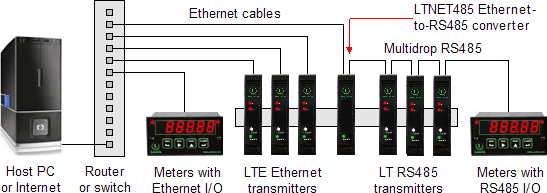
MLTE-QD | Ethernet & 4-20 mA Output | Quadrature Position or Rate | DIN Rail Transmitter
The Micron Meters Quadrature transmitter accepts A & B quadrature encoder signals to provide an analog output that tracks position, length, angle, or rate. The A & B quadrature signals are 90° out of phase, and their phase relationship determines whether up counts (+) or down counts (-) are produced.
One, two or four quadrature transitions may be counted at a maximum combined rate of 250 kHz and be scaled internally to ±999,999 counts. The input circuitry may be jumpered for either single-ended input signals or for balanced line driver signals. Anti-jitter circuitry eliminates errors produced by vibration of the encoder. In the event of a power failure, the latest total may be stored in non-volatile memory and can be used as the starting point for counting when power resumes. Power fail or zero index capabilities are alternate meter setup choices.

A zero index pulse, if available, is interpreted as indicating a zero reference for an integral number of revolutions of a rotary shaft encoder or the home position of a linear encoder. It is used by the meter for initializing and to correct for any cumulative pulse count errors. Special circuitry corrects for width of the zero index pulse.
Available for Total or Rate
- With the Standard main board, the transmitter totalizes the quadrature counts and then scales the total in software for the output. A zero index Z signal can be added as a third input to the A & B signals. The analog output is generated by an ultra-linear 16-bit (65,536 step) digital-to-analog converter (DAC) for 0.02% output accuracy.
- With the Extended main board, the transmitter can be programmed to output either total or rate or rate. For example, the output can track the speed of a moving slab from the RPM of a roller. The update rate for rate is a programmed gate time + 30 ms + 0-2 pulse periods.
- Ethernet I/O, isolated. Supported protocols are Modbus RTU and ASCII (tunneled via Modbus TCP) and Custom ASCII. The latter is simpler than the Modbus protocol and is recommended when all devices are Micron units. Note that RS232 or RS485 data I/O in lieu of Ethernet is provided by MLT Series transmitters.
- 4-20 mA, 0-20 mA or 0-10V analog transmitter output, isolated, jumper-selectable and user scalable. All selections provide 16-bit (0.0015%) resolution of output span and 0.02% output accuracy of a reading from -99,999 to +99,999 counts that is also transmitted digitally. Output isolation from signal and power grounds eliminates potential ground loop problems. The supply can drive 20 mA into a 500 ohm (or lower) load for 10V compliance, or 10V into a 5K ohm (or higher) load for 2 mA compliance.
- Dual solid state relays, isolated. Available for local alarm or control. Rated 120 mA at 130 Vac or 180 Vdc.
- Universal 85-264 Vac power. Low-voltage 10-48 Vdc or 12-32 Vac power is optional.
Discovery and configuration of Laureate Ethernet Nodes is easily achieved with Laurel's Node Manager Software, and the discovered transmitters can then be programmed using Laurel's Instrument Setup Software. Both software's run on a PC under MS Windows and can be downloaded from this website at no charge.

![]() MLTE-QD Quadrature Transmitter | Support Library
MLTE-QD Quadrature Transmitter | Support Library
Data Sheet | User Manual
